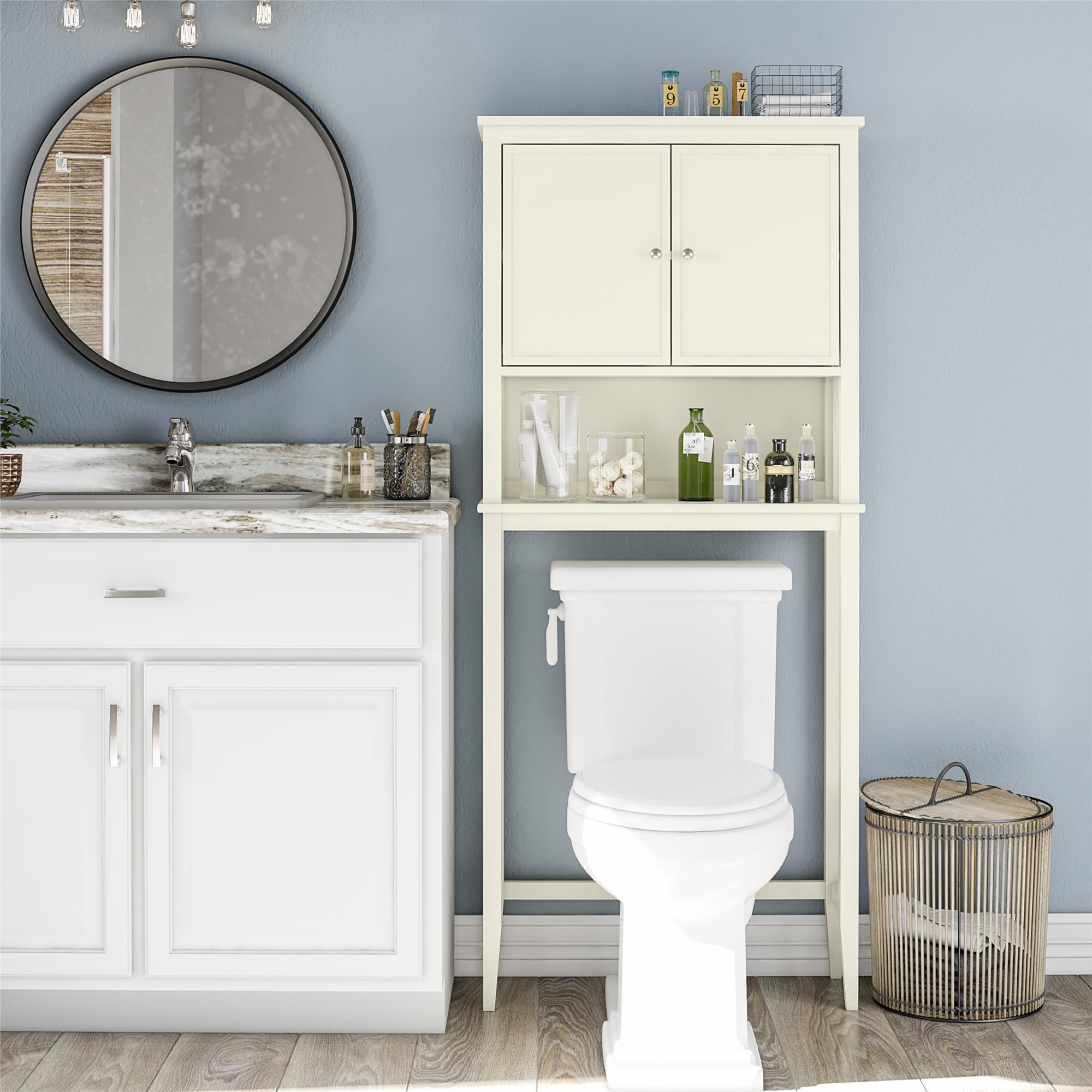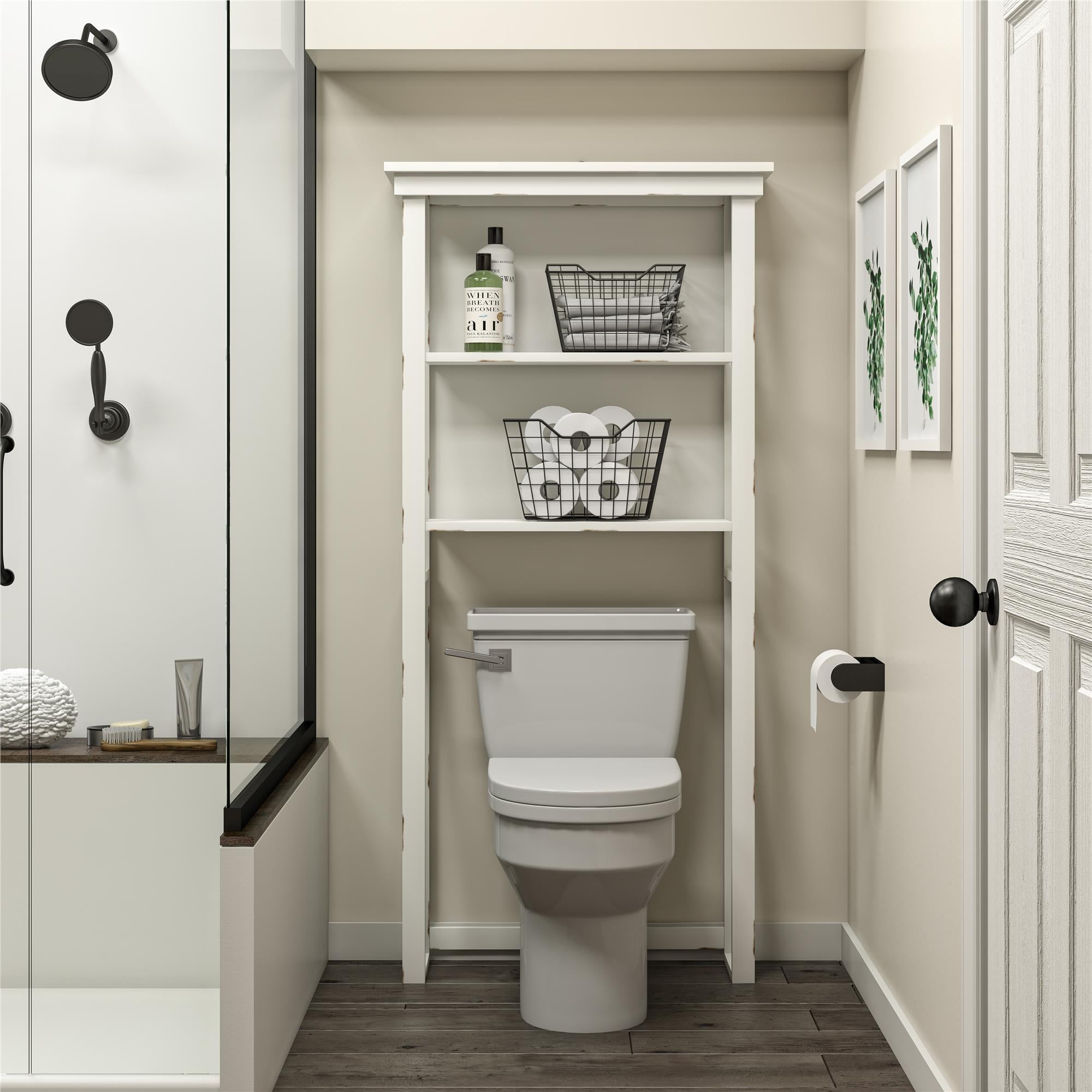Space-Saving Solutions
Maximizing limited bathroom space is a common design challenge, particularly in smaller homes or apartments. Above-toilet storage offers a practical and aesthetically pleasing solution, especially when utilizing the often-underutilized vertical space. White cabinets, in particular, contribute to a clean, bright, and spacious feel, enhancing the overall bathroom ambiance. This section explores various design options and installation procedures for maximizing this often-neglected area.
White Cabinet Designs for Above-Toilet Storage
Three distinct white cabinet styles, catering to different aesthetic preferences and storage needs, are presented below. Each design considers practicality, material durability, and cost-effectiveness. Careful consideration of dimensions is crucial to ensure the cabinet fits seamlessly above the toilet without obstructing access or creating a cramped feel.
| Style | Dimensions (W x D x H) | Material | Estimated Cost |
|---|---|---|---|
| Minimalist Floating Shelf | 24″ x 8″ x 12″ | White lacquered MDF | $100 – $150 |
| Traditional Cabinet with Doors | 24″ x 12″ x 30″ | White painted solid wood (pine) | $250 – $400 |
| Modern Cabinet with Open Shelving | 30″ x 10″ x 24″ | White high-gloss acrylic | $300 – $500 |
Installing a Small, Floating White Cabinet Above a Toilet
Before commencing installation, ensure all necessary tools and safety precautions are in place. Improper installation can lead to damage or injury. Always disconnect the power supply to any nearby electrical outlets.
White cabinet above toilet – The following steps Artikel the installation process for a small, floating white cabinet. This assumes the cabinet is pre-assembled and has pre-drilled mounting holes.
- Mark the Wall: Carefully measure and mark the desired location on the wall, ensuring it aligns correctly above the toilet and is level. Consider the cabinet’s height and ensure sufficient clearance for the toilet lid to open and close.
- Locate Studs: Use a stud finder to locate wall studs. Securing the cabinet directly to studs provides the most robust support.
- Drill Pilot Holes: Drill pilot holes at the marked locations, using a drill bit slightly smaller than the screws provided with the cabinet.
- Secure the Cabinet: Attach the cabinet to the wall studs using appropriate screws. Ensure the cabinet is level and securely fastened.
- Inspect and Finalize: Inspect the installation to ensure the cabinet is securely mounted and level. If necessary, make minor adjustments.
Visual Description of a White Cabinet in a Small Bathroom
Imagine a small, contemporary bathroom with crisp white subway tiles covering the walls. A small, floating white cabinet, approximately 24″ wide and 12″ deep, is mounted directly above the toilet. The cabinet features two sleek, minimalist doors, concealing storage for toiletries and cleaning supplies. Soft, recessed LED lighting above the cabinet illuminates the space, highlighting the clean lines and enhancing the sense of spaciousness. A chrome towel rack and a simple, white pedestal sink complete the minimalist aesthetic, creating a bright and airy feel despite the limited space. The overall style is clean, modern, and maximizes the vertical space. The white cabinet acts as a focal point, drawing the eye upward and creating a sense of openness that belies the small size of the bathroom.
Style and Functionality

The strategic placement of a white cabinet above a toilet offers a compelling blend of practicality and aesthetic appeal, significantly impacting the overall bathroom design. Its functionality, primarily storage, is enhanced by its ability to seamlessly integrate into various interior design styles, while its color contributes to a brighter, more spacious feel. The following explores how a white cabinet above the toilet can transform different bathroom aesthetics.
White Cabinets in Diverse Interior Design Styles, White cabinet above toilet
The versatility of a white cabinet makes it an adaptable element across diverse design aesthetics. Its neutral tone allows it to complement rather than clash, providing a clean canvas upon which to build a cohesive bathroom design.
- Modern: Modern bathrooms prioritize clean lines, minimalist aesthetics, and functionality. A white cabinet above the toilet, ideally with sleek, handleless doors and a simple, geometric design, perfectly embodies this style. The cabinet’s unfussy form avoids visual clutter, contributing to the overall sense of calm and order. Its white finish enhances the feeling of spaciousness, a key element in modern design.
- Farmhouse: Farmhouse style emphasizes rustic charm and natural materials. A white cabinet in this setting could incorporate features like slightly distressed paint, slightly visible wood grain, or perhaps even decorative knobs with a vintage feel. This softens the starkness of the white, allowing it to blend seamlessly with the overall rustic aesthetic. The cabinet’s functionality remains paramount, offering storage for everyday essentials while adding to the homey atmosphere.
- Traditional: Traditional bathrooms often feature ornate details, rich textures, and a sense of timeless elegance. A white cabinet in a traditional bathroom might have more elaborate detailing – perhaps raised panels or decorative molding – to complement the existing décor. The white provides a bright contrast against darker elements, preventing the bathroom from feeling too heavy or cluttered. The cabinet offers necessary storage without detracting from the room’s classic character.
Creative Uses of Toilet-Above Cabinet Space
Beyond basic storage, a white cabinet above a toilet presents opportunities for creative organization and display.
- Linen Closet: Organize extra towels, washcloths, and hand towels neatly folded on shelves. Consider using drawer dividers for smaller items. This keeps linens readily accessible yet out of sight.
- Medicine Cabinet Alternative: Store frequently used toiletries and medications, keeping them organized and easily accessible. Utilize small baskets or containers to separate items by type.
- Fragrance and Diffuser Station: Display beautifully arranged candles, essential oil diffusers, and fragrant soaps. This transforms the cabinet into a visually appealing and aromatic focal point.
- Bathroom Reading Nook: Keep a small collection of books, magazines, and a comfortable reading light inside. This creates a small, private reading area in the bathroom.
- First-Aid Station: Store a well-stocked first-aid kit, including bandages, antiseptic wipes, and pain relievers, ensuring easy access in case of minor injuries.
Maximizing Light and Space with White Cabinets
The use of white cabinets above toilets significantly contributes to the overall brightness and spaciousness of a bathroom, particularly in smaller spaces. White reflects light exceptionally well, bouncing light around the room and creating a brighter, airier atmosphere. In a small bathroom, this effect can be transformative, making the space feel significantly larger than it actually is. Imagine the soft, diffused light reflecting off the clean, white surfaces, creating a sense of openness and tranquility. The lack of dark, visually heavy cabinetry further contributes to this spacious feeling. The clean, bright aesthetic creates a welcoming and relaxing environment, enhancing the overall bathroom experience.
Alternative Materials and Designs: White Cabinet Above Toilet

The standard white wooden above-toilet cabinet, while functional, offers limited scope for design innovation and material exploration. Expanding beyond the conventional opens up exciting possibilities in terms of both aesthetics and practicality, allowing for greater personalization and a wider range of styles to complement diverse bathroom designs. This section explores alternative materials and unconventional designs to showcase the potential for creativity and functionality in this often-overlooked space.
Material Comparison for Above-Toilet Cabinets
Choosing the right material significantly impacts the longevity, maintenance, and overall aesthetic of an above-toilet cabinet. The bathroom environment presents unique challenges due to humidity and potential water exposure. Therefore, careful consideration of material properties is crucial. The following table compares the suitability of several materials commonly used in bathroom furniture.
| Material | Durability | Maintenance | Cost |
|---|---|---|---|
| Wood (Standard) | Moderate; susceptible to moisture damage if not properly sealed. | Requires regular sealing and cleaning; vulnerable to water stains. | Moderate to High |
| Metal (Stainless Steel/Powder-Coated) | High; resistant to moisture and corrosion. | Easy to clean; requires minimal maintenance. | High |
| Glass | High; resistant to moisture and easy to clean. | Easy to clean; prone to smudges and fingerprints. | Moderate to High |
| Acrylic | Moderate; susceptible to scratches but generally water-resistant. | Easy to clean; requires careful handling to avoid scratches. | Moderate |
Non-Standard Cabinet Designs
Moving beyond the typical rectangular shape allows for enhanced functionality and visual appeal. Three distinct designs illustrate this potential.
Design 1: Slim, Tall Cabinet with Integrated Mirror
This design maximizes vertical space, ideal for smaller bathrooms. A tall, narrow cabinet, perhaps only 12 inches wide, could house ample storage while incorporating a full-length mirror on its front surface. This combines storage and functionality, addressing the common bathroom need for extra mirror space. The slim profile prevents it from overwhelming the small space.
Design 2: Curved Cabinet with Open Shelving
A curved cabinet, perhaps with a gentle S-curve, offers a visually softer aesthetic than a standard rectangular design. Combining closed storage with open shelving adds visual interest and allows for displaying decorative items or frequently used toiletries. The curved shape could also help to soften the harsh lines of a rectangular bathroom.
Design 3: Modular Cabinet System
This design offers adaptability and customizability. Several smaller, individual cabinets of varying sizes and depths could be combined to create a unique configuration tailored to the specific needs and space of the bathroom. This allows for flexibility in storage solutions and a personalized look, avoiding the limitations of a single, fixed-size unit. For example, one module could be tall and narrow for toiletries, another shallow and wide for folded towels, and a third could incorporate a small pull-out drawer for frequently used items.
Sustainable and Eco-Friendly Above-Toilet Cabinets
The production of conventional above-toilet cabinets often involves unsustainable practices, from deforestation to the use of harmful finishes. A more responsible approach prioritizes sustainable materials and construction methods. This could involve utilizing reclaimed wood, bamboo, or rapidly renewable timber species for the cabinet’s structure. Finishes should be non-toxic and water-based, minimizing volatile organic compounds (VOCs) released into the bathroom environment. Furthermore, prioritizing locally sourced materials reduces transportation emissions and supports local economies. Designers should also consider using durable, long-lasting materials to reduce the need for frequent replacements, contributing to a circular economy approach. The use of recycled materials in construction and packaging is also paramount in minimizing environmental impact. For example, a cabinet could be constructed from reclaimed pallet wood, sealed with a natural beeswax finish, and packaged using recycled cardboard.
